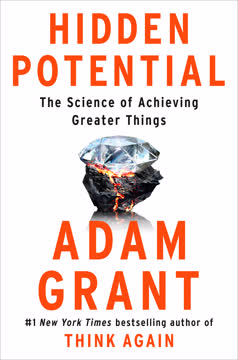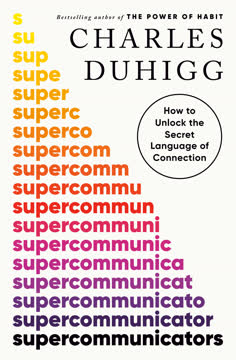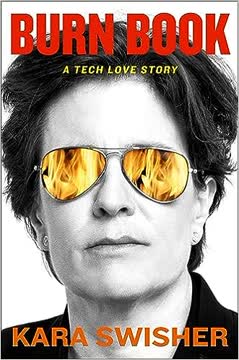Key Takeaways
1. Culture is a realized meaning-making system that shapes our identity and behavior
Culture is a realized meaning-making system that is anchored in our identity (who we are) and made up of three elements: how we see the world, our shared way of life, and the creation of shared expression.
Three systems of culture. Culture consists of three interconnected systems:
- How we see the world (beliefs and ideologies)
- Our shared way of life (artifacts, behaviors, and language)
- Cultural production (creative output reflecting our perspective)
These systems work together to create a comprehensive operating system that governs our daily lives. Our cultural affiliations influence everything from our consumption habits to our political views and social interactions.
Identity and worldview. Our identity is closely tied to our cultural subscriptions, which in turn shape our worldview. This relationship is the cornerstone of social life and tribal membership. When there's alignment between our identity and a brand's or organization's beliefs, we're more likely to engage with and support them.
2. Find your congregation: Target people who share your worldview
If you want to inspire people to move, your best chance is to find your congregation—the aggregate tribes of people who see the world the way you do.
Networked tribes. Instead of targeting broad demographics, focus on finding the congregation of people who share your beliefs and ideologies. These networked tribes are more likely to act in concert because of their shared identity and cultural subscriptions.
Segmentation and targeting. Divide the market into two segments: believers and non-believers. Target the believers, as they are more inclined to move based on who they are rather than what your product or service offers. Remember that there are likely more believers out there than you realize, as multiple tribes can combine to create congregations.
Congregation characteristics:
- Shared beliefs and ideologies
- Common cultural practices
- Use of specific artifacts and language
- Strong sense of identity tied to the group
3. Preach the gospel: Communicate your beliefs to inspire action
Preach the gospel to the congregation of believers and they will move because of who they are and how they see the world.
Start with the soul, end with the sale. When communicating with your congregation, focus on expressing your beliefs and worldview rather than leading with product features and benefits. This approach connects with people on an emotional level, activating the limbic system of the brain and inspiring action.
The power of conviction. Brands and organizations that clearly articulate their beliefs and stand firm on their convictions are more likely to inspire collective behavior. Examples include:
- Patagonia's commitment to environmental sustainability
- Nike's belief that every human body is an athlete
- Apple's challenge to the status quo
By preaching your gospel to those who share your worldview, you create a powerful connection that transcends traditional marketing approaches and inspires people to move based on their identity.
4. Achieve meaning congruence to connect with your audience
It's not what you say, it's what people hear.
Understanding meaning-making. Meaning is subjective and culturally mediated. To connect with your audience, you must understand how they interpret and make sense of the world based on their cultural subscriptions.
Four mechanisms of meaning-making:
- Responding: How community members participate in evaluation and legitimation
- Recontextualizing: Taking a product from one context and placing it in another
- Reconciling: Pursuing cognitive consonance when behavior is out of sync with cultural norms
- Reinforcing: Signaling appraisal through repetition
Fashioning systems. Consider the various ways meaning is moved from culture to brands:
- Advertising
- News and magazines
- High-esteem individuals
- Fringe societies
- Peer fashioning (introduced by the author)
To achieve meaning congruence, ensure that your intended message aligns with how your audience interprets it within their cultural frames.
5. Understand and adapt to the speed of cultural change
The only constant in life is change, as the ancient Greek philosopher Heraclitus so poignantly noted centuries ago—and it is the same for culture.
Fast and slow culture. Recognize the difference between fast culture (observable cultural expressions) and slow culture (underlying beliefs and values). While fast culture can change rapidly, slow culture evolves over longer periods.
Cultural shifts. Be aware of how cultural shifts can impact meaning and interpretation. What was once acceptable or popular can quickly become outdated or offensive. Stay attuned to these changes to maintain relevance and avoid potential backlash.
Accelerated change. Modern technology and social media have accelerated the speed of cultural change. This creates both challenges and opportunities for brands and organizations to adapt quickly and participate in cultural conversations.
6. Leverage cultural codes to create powerful brand connections
To impact culture, you must operate at the ever-changing speed of culture with a keen understanding of the social facts that govern the community.
Cultural intimacy. Develop a deep understanding of the cultural codes that govern your target community. This requires immersion and empathy to truly grasp the nuances of their worldview and behavior.
Methods for gaining cultural insights:
- Ethnographies and netnographies
- Social listening and online community observation
- Immersive experiences within the community
Creating cultural products. Use your understanding of cultural codes to create products, campaigns, or experiences that resonate deeply with your audience. These cultural products should allow community members to express their identity and connect with others who share their worldview.
Examples of successful cultural products:
- McDonald's "Famous Orders" campaign
- Beats by Dre's "You Love Me" film
- The Blair Witch Project's innovative marketing approach
7. Recognize the responsibility in storytelling and cultural production
We bear a great responsibility when we use storytelling as a vessel to preach the gospel.
The power of stories. Recognize that stories shape how we see the world and influence our behavior. As a marketer or leader, you have the power to impact people's perceptions and actions through the stories you tell.
Ethical considerations. When leveraging culture and storytelling, consider the following:
- Your intentions
- The perspective of others
- Potential outcomes
Cultural appreciation vs. appropriation. Be mindful of the difference between cultural appreciation and appropriation. Approach other cultures with respect, curiosity, and a willingness to learn before attempting to leverage aspects of them.
Positive impact. Use your newfound understanding of culture and storytelling to create positive change. Consider how you can use these tools to address societal issues, promote understanding, and bring people together.
Last updated:
FAQ
What's For the Culture about?
- Cultural Influence: For the Culture by Marcus Collins explores how culture shapes our identities, behaviors, and consumption patterns. It highlights culture as a powerful force that influences our worldview and actions.
- Identity and Beliefs: The book examines the relationship between identity, beliefs, and cultural practices, suggesting that our actions are driven by a desire to align with the cultural traits of our tribes.
- Practical Applications: Collins offers insights for marketers, leaders, and entrepreneurs on leveraging cultural understanding to inspire collective behavior and drive brand engagement.
Why should I read For the Culture?
- Understanding Human Behavior: The book provides a comprehensive look at the social dynamics governing human behavior, essential for those interested in marketing, leadership, or social influence.
- Cultural Frameworks: Collins presents frameworks for understanding culture, identity, and community, applicable in various professional contexts to enhance effectiveness and engagement.
- Real-World Examples: It includes case studies, such as Patagonia and Nike, illustrating how successful brands connect with audiences through shared beliefs and cultural narratives.
What are the key takeaways of For the Culture?
- Culture Drives Behavior: Culture is the most predictable vehicle for influencing behavior at scale, allowing deeper connections with audiences.
- Find Your Congregation: Instead of targeting broad audiences, identify and engage with specific congregations—groups sharing similar beliefs and ideologies.
- Preach the Gospel: Effective communication should start with articulating beliefs and values before discussing product features, resonating more emotionally with audiences.
How does Marcus Collins define culture in For the Culture?
- Culture as a System: Collins defines culture as a "realized meaning-making system" anchored in identity and shaped by shared beliefs and ideologies.
- Three Systems of Culture: The book outlines three systems: beliefs (how we see the world), behaviors (our shared way of life), and cultural production (artifacts).
- Cultural Characteristics: These characteristics govern community behavior and interaction, making culture a powerful tool for influencing actions.
What is the significance of "congregation" in For the Culture?
- Definition of Congregation: A congregation is a group sharing a common worldview, influencing behaviors and consumption patterns, extending beyond religious contexts.
- Cultural Practitioners: Congregations establish norms, values, and behaviors, helping members navigate social environments and reinforcing identities.
- Targeting Believers: Businesses and leaders should focus on congregations rather than broad audiences, as these groups are more likely to adopt behaviors aligned with their beliefs.
What are the "fashioning systems" mentioned in For the Culture?
- Four Fashioning Systems: Collins identifies advertising, news and media, high-esteem individuals, and fringe societies as systems infusing meaning into products.
- Cultural Production: These systems create cultural products reflecting community beliefs and ideologies, allowing brands to resonate deeply with audiences.
- Meaning Movement: The systems facilitate the movement of meaning from cultural production to consumption, ensuring products are culturally significant.
How does For the Culture address cultural appropriation?
- Cultural Appropriation vs. Appreciation: Collins distinguishes between appropriation and appreciation, emphasizing respect and understanding of cultural significance.
- Examples of Appropriation: The book provides examples, such as the co-opting of Black cultural practices, illustrating power dynamics in cultural exchanges.
- Ethical Storytelling: Collins advocates for storytelling that honors cultural origins, encouraging marketers to engage with communities in empowering ways.
What is the peer fashioning system mentioned in For the Culture?
- Definition of Peer Fashioning System: This concept describes how meaning is constructed within communities, emphasizing communal evaluation and legitimation.
- Mechanisms of Evaluation: The system includes responding, recontextualizing, reconciling, and reinforcing, illustrating community discussions shaping brand perceptions.
- Cultural Solidarity: It fosters social solidarity, with community members collectively evaluating and legitimating cultural products, reinforcing shared identities.
How does social contagion work according to For the Culture?
- Definition of Social Contagion: Social contagion is the process by which behaviors, ideas, and cultural practices spread within communities.
- Role of Community: Community plays a crucial role, as individuals are more likely to adopt behaviors observed in others.
- Cultural Influence: This phenomenon illustrates how cultural narratives influence consumer behavior, which marketers can leverage for brand loyalty.
What does Collins mean by "preaching the gospel"?
- Communicating Beliefs: Preaching the gospel involves articulating a brand's beliefs and values to inspire action among a congregation.
- Emotional Connection: This approach connects with audiences emotionally, activating the limbic system, which drives behavior more effectively than rational arguments.
- Collective Action: Successful preaching can mobilize a congregation to take action, as seen in campaigns like REI's #OptOutside.
What is the significance of storytelling in For the Culture?
- Cultural Narratives: Storytelling shapes cultural narratives and influences behavior, establishing social norms and expectations.
- Connection and Identity: Stories foster connections by reinforcing shared beliefs and values, expressing identity and belonging within a group.
- Ethical Considerations: Marketers have a responsibility to tell stories ethically, understanding cultural context to avoid misrepresentation.
What are the best quotes from For the Culture and what do they mean?
- "Culture is contagious...": This quote underscores culture's role in shaping behavior, suggesting that understanding cultural dynamics leads to effective strategies.
- "People don’t buy what you do...": Highlights the importance of articulating beliefs in marketing, suggesting emotional connections drive behavior more than features.
- "I am, therefore I do.": Encapsulates the idea that actions reflect identities and beliefs, emphasizing alignment between identity and cultural practices.
Review Summary
For the Culture receives mostly positive reviews, praised for its insightful exploration of culture's impact on marketing and society. Readers appreciate Collins' blend of personal anecdotes, research, and cultural analysis. Some find the writing style engaging, while others consider it repetitive or overly academic. The book's examination of cultural movements and their influence on consumer behavior is highlighted as valuable. Critics note the book's political leanings and occasional lack of focus. Overall, it's recommended for marketers and those interested in cultural dynamics.
Similar Books









Download PDF
Download EPUB
.epub digital book format is ideal for reading ebooks on phones, tablets, and e-readers.




